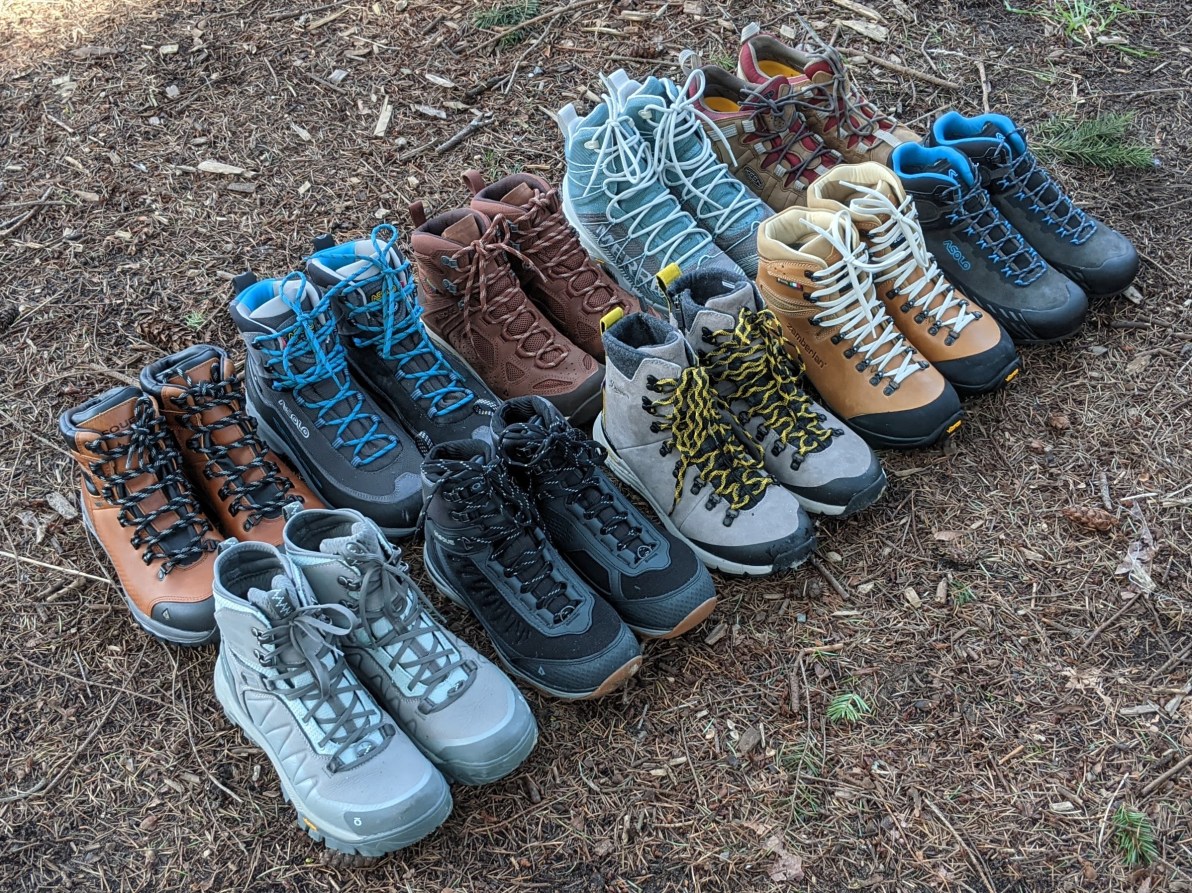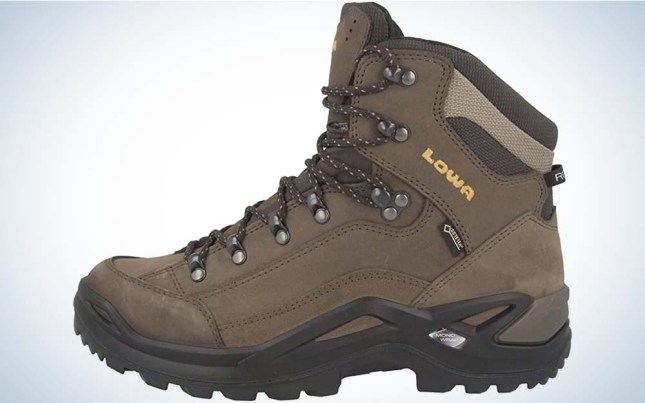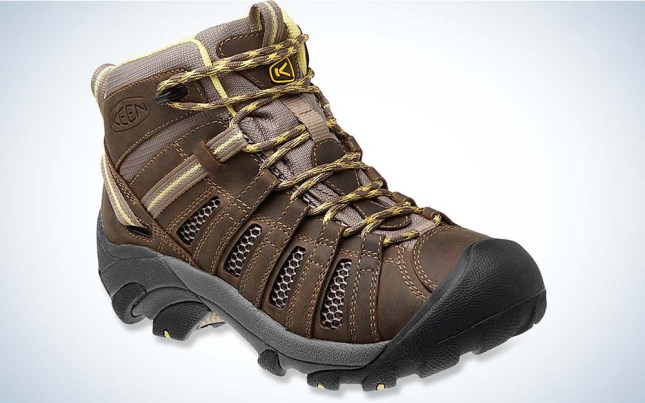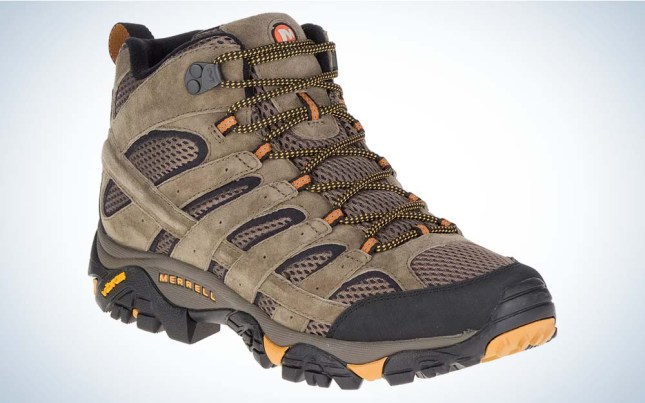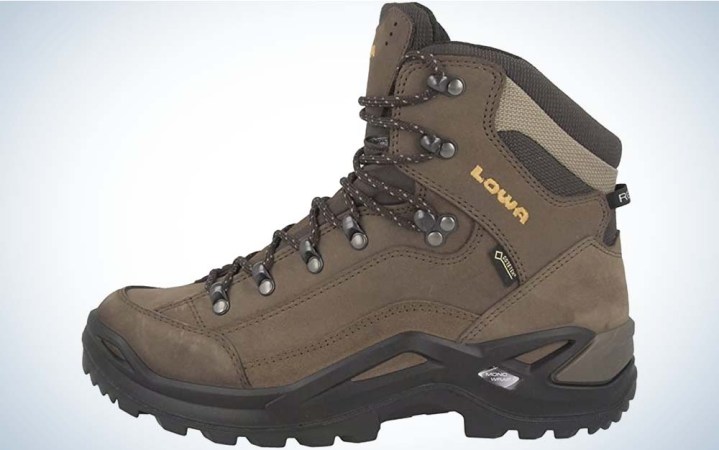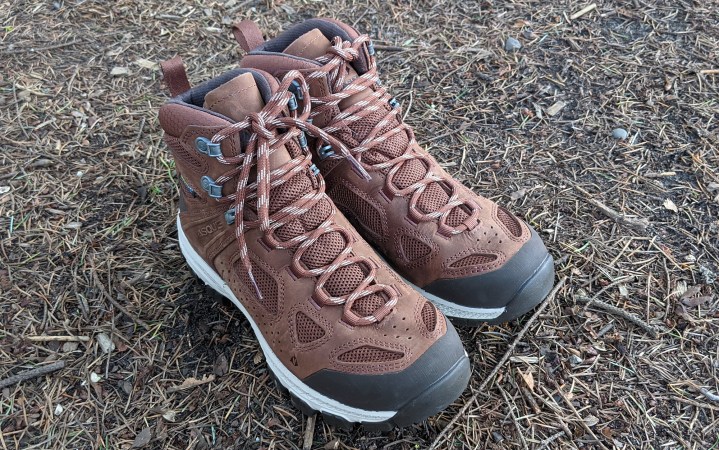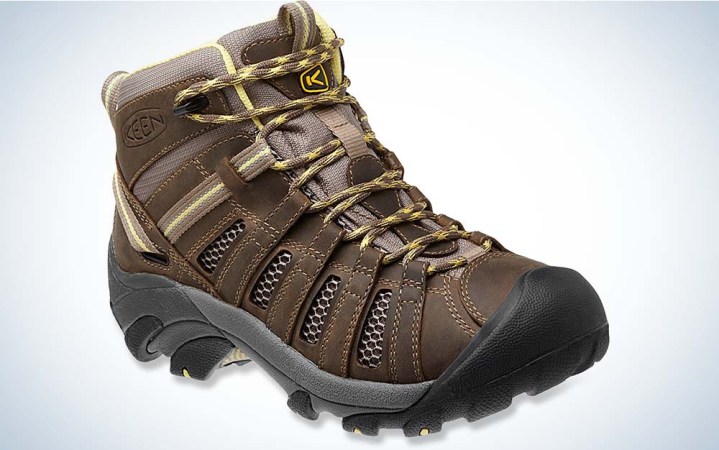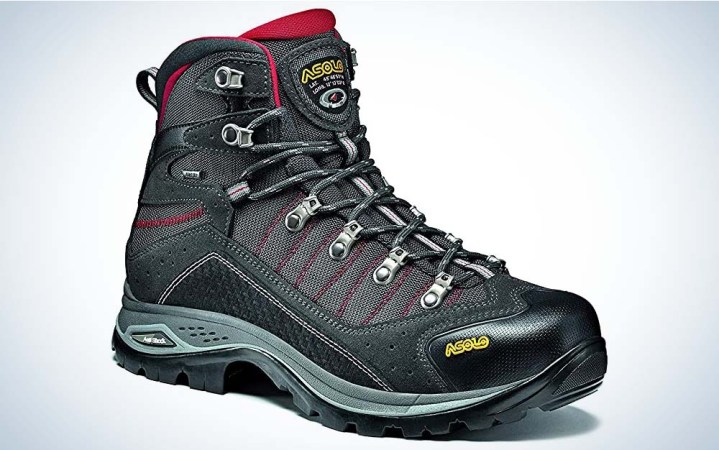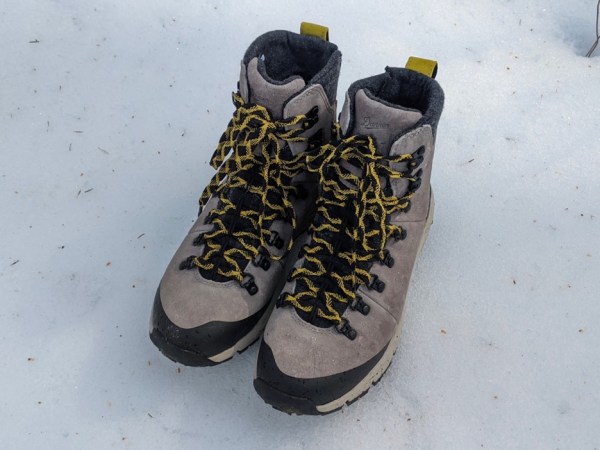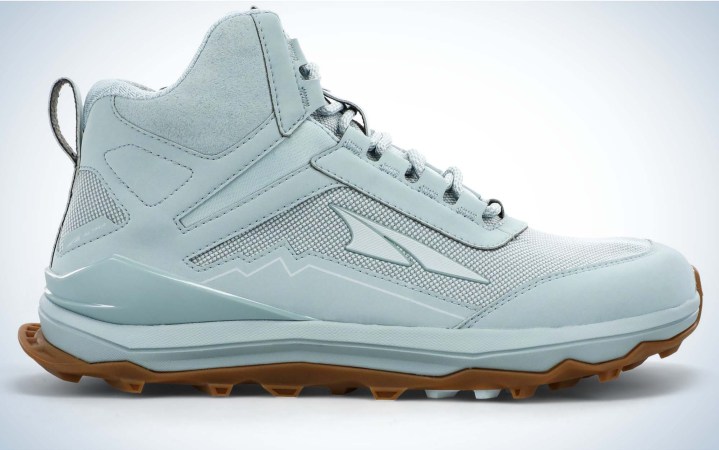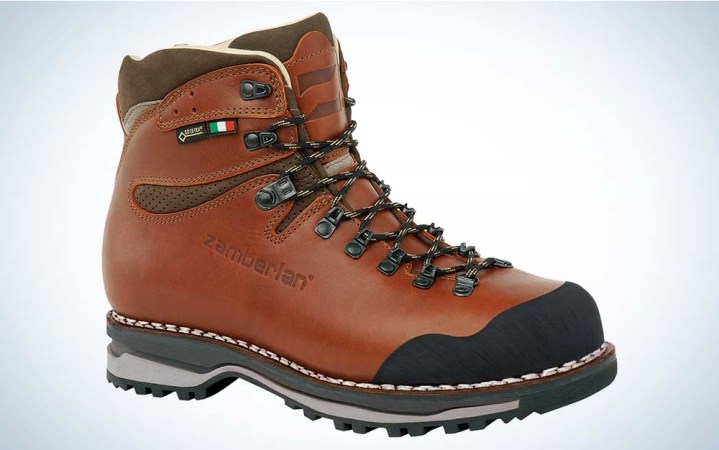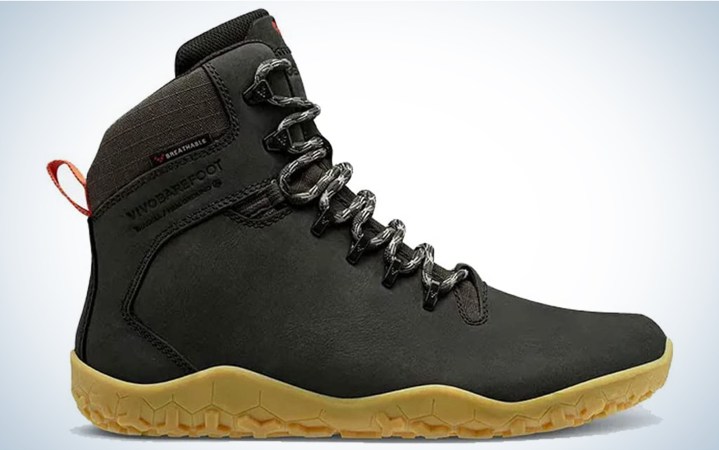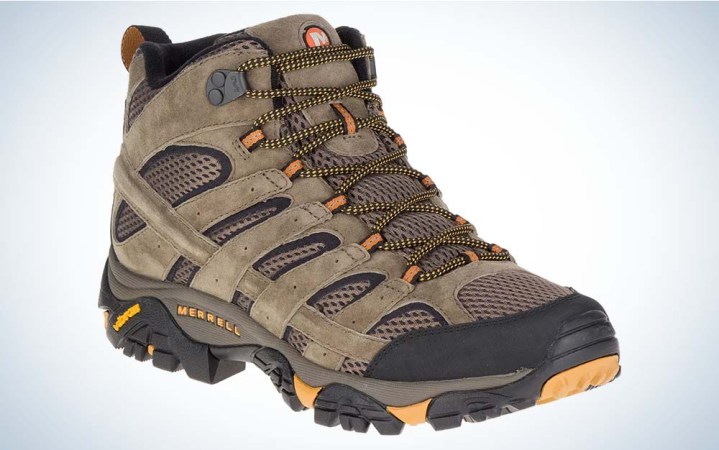We may earn revenue from the products available on this page and participate in affiliate programs. Learn More ›
Over the last decade, there’s been a pronounced shift away from hiking boots in favor of hiking shoes and even trail runners. But for those who prefer the security and durability of a traditional hiking boot, there are a number of excellent options, ranging from low-cost mids to full-leather boots that can last a lifetime. To find the best hiking boots on the market, Outdoor Life interviewed the top brands, tested top models for their winter and waterproof bona fides, and dived into the results of a poll conducted by the Colorado Mountain Club of its members. Here are our top picks:
- Best Overall: Lowa Renegade GTX Mid Hiking Boots
- Best Waterproof: Vasque Breeze
- Best for Wide Feet: KEEN Voyageur Mid Hiking Boots
- Best for Narrow Feet: Asolo Drifter GV Evo Hiking Boots
- Best for Winter: Danner Arctic 600
- Most Comfortable: Altra Lone Peak Hiker
- Best Leather: Zamberlan 1025 Tofane NW GTX RR
- Best Barefoot: Vivobarefoot Tracker
- Best Budget: Merrell Moab 3
How We Chose the Best Hiking Boots
As one member of the Colorado Mountain Club put it, “Feet are like Mr. Rogers’ Neighborhood, every one is special and different.” Compounded with what is perhaps the hiking boots best-known attribute—their longevity—this can make a typical testing regime challenging. What works for one foot over the course of a decade may swiftly result in injury for someone else. Anyone committed to hiking boots as their footwear of choice, as opposed to hiking shoes or trail runners, knows that finding the right fit requires considerable trial and error. But once you find you a hiking boot that works for you, that could be your boot for life.
The OL picks for best hiking boot come from our in-depth tests of the best waterproof hiking boots and the best winter hiking boots. We also reviewed an in-depth poll the Colorado Mountain Club ran to find out what had that for their members across a range of foot types and for loads ranging from sub-10 pounds to over 30. Finally, we spoke with some of the best hiking boot brands to learn more about what makes their footwear stand out.
Best Hiking Boots: Reviews & Recommendations
Best Overall: Lowa Renegade GTX Mid
Key Features
- Weight: Men’s 2 pounds, 7 ounces; Women’s 2 pounds, 2 ounces
- Lining: Gore-Tex waterproof breathable membrane/polyester
- Upper: Nubuck leather/Cordura nylon
- Outsole: Vibram Evo
- Available in regular, narrow, and wide
- Cannot be resoled
Pros
- Comfortable
- Short break-in period
- Great tread that grips well to a variety of surfaces
- Waterproof
Cons
- Less durable than other options
True hiking boots can be uncomfortable the first few (or dozen) times you take them on a hike. This break-in period is one of the most common reasons people switch to hiking shoes or trail runners. But CMC members found the Lowa Renegades to bridge this gap. “They were very comfortable from the first time I put them on,” one member said.
Like the majority of great hiking boots, these come with a Gore-Tex waterproof liner and Vibram sole that ensures the Renegades grip well on a wide variety of terrains. The combination leather and Cordura upper provides additional waterproofing and, over time, forms to the foot for a secure fit.
The use of polyurethane in the midsole, while more comfortable for a wide range of hikers and backpackers, isn’t the most durable and can degrade over time. One CMC member noted that they “don’t last very long” compared to other hiking boots.
Best Waterproof: Vasque Breeze
Best Overall
Vasque Breeze
Key Features
- Sizes: Men’s 7-14; women’s 6-12
- Recycled polyester mesh, Nubek waterproof leather, Vasque Trail Strider outsole
- VasqueDry waterproofing
- Runs small and narrow
Pros
- Fully waterproof
- Affordably priced
- Dries fairly quickly
- Reasonably lightweight
Cons
- Tight fit may be uncomfortable for some
The Vasque Breeze won top honors in our review of the best waterproof hiking boots: It was completely dry after being left in several inches of water for sixteen hours, and then stayed dry in my second test, where I threw all of the salt and mud and sun that I could at it and then left it again in submerged water. And it manages all that while coming in at a fairly affordable (at least for hiking boots) price tag. The lightweight design of the Vasque Breeze also offers more breathability than other waterproof hiking boots, and it performed well during the dry-time test.
I recommend sizing up for the Vasque Breeze (which runs small) and also walking around for some time before committing to a final purchase. This boot is on the narrow side, and some hikers may find that it is putting more sideways pressure on the forefoot than they prefer.
Best for Wide Feet: KEEN Voyageur Mid
Key Features
- Weight: Men’s 2 pounds; Women’s 1 pound, 11.5 ounces
- Lining: Synthetic
- Upper: Leather and polyester mesh
- Outsole: Rubber
- Available in regular sizes
- Cannot be resoled
Pros
- Wide toe box allows the toes to splay more naturally
- Good tread handles a variety of terrains
- Reasonably priced
Cons
- Less durable
- Not as comfortable with heavy loads
Hikers and backpackers with wider-than-average feet can run into a range of problems, ranging from blisters to more serious injuries. KEEN has long been known to run substantially wider than standard hiking boots and incorporate a larger toe box into their designs. The Voyageur was popular with CMC members in part for this reason. One member who dealt with plantar fasciitis said, “changing to the Keens helped resolve the issue.” (Another KEEN mainstay, the Targhee, also won top honors in our roundup of the best hiking shoes for wide feet.)
This shoe was less popular for backpackers used to carrying loads over 30 pounds, because of the reduced cushion in the footbed. But the lighter overall weight of this shoe compared to those with heavier cushioned shoes makes this a comfortable day hiking choice, even on longer trails.
Best for Narrow Feet: Asolo Drifter GV Evo
Key Features
- Weight: Men’s 2 pounds, 11 ounces; Women’s 2 pounds, 6 ounces
- Lining: Gore-Tex Performance Comfort
- Upper: Water-resistant suede and Cordura
- Outsole: Vibram Duo Radiant with Megagrip compound
- Available in regular
- Can be resoled
Pros
- Long lasting
- Waterproof
- Good balance of support and weight
Cons
- Expensive
The Asolo Drifter GV Evos have all the hallmarks of a great pair of hiking boots: a durable upper made from waterproof Cordura, and a Gore-Tex liner that keeps feet dry even in the unpredictable afternoon rain storms of the Rockies. The Vibram outsole (which is replaceable, can keep this boot in commission for many years) grips well and holds onto less dirt and debris.
Unlike the roomier toe boxes typically seen on trail runners, the Asolo Drifters narrow at the toes. That, combined with the overall slimmer shape of the shoe, made this one an ideal fit for CMC members with narrower feet, locking their heels in place without pinching once laced up.
Best for Winter: Danner Arctic 600
Key Features
- Sizes: Men’s 7-14 (wide available); women’s 5-11
- Outsole: Vibram Nisqually Arctic Grip
- Insulation: 200g Primaloft Gold
- Danner Dry liner
Pros
- Best traction on ice in my test
- Very warm
- Side zip allows for easy on and off
Cons
- Side zip represents a point of failure
The Danner Arctic 600 was the winner of my test of the best winter hiking boots. The Vibram Arctic Grip outsole (in combination with this shoe’s lug design) was extremely impressive. The stickiness of the traction meant I could barely tell I was walking on ice—it was almost impossible to slip with these shoes. Similarly this shoe stayed warmer than every other boot in my test while standing in the early spring runoff of the Middle Fork of the Snoqualmie River, and no moisture made its way into the boot. I did note, however, that this boot was the coldest at the side zipper.
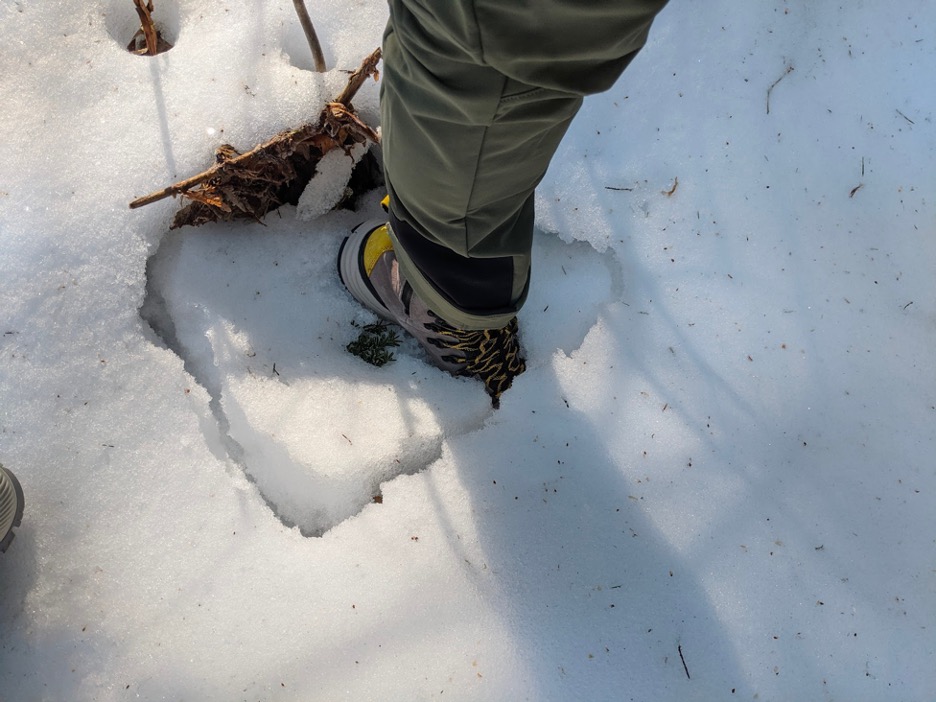
The Danner Arctic 600’s side zipper was an unusual feature among the boots that I tried. While putting on and taking off boots seemingly every fifteen minutes, I appreciated that I could put on and remove these shoes without having to untie and retie the laces.
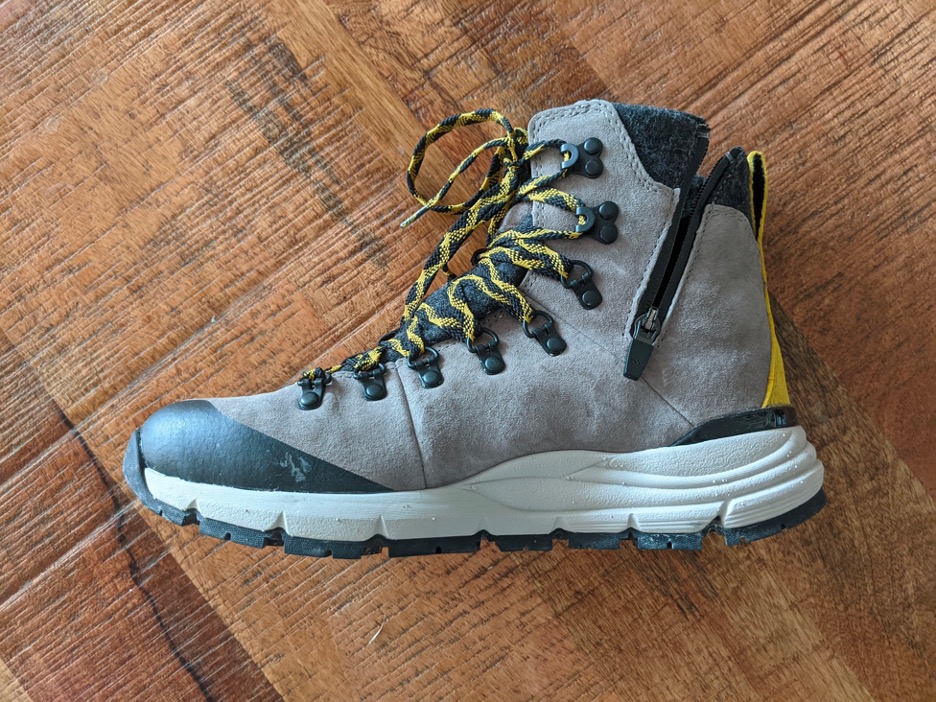
But as everyone who spends time outdoors knows, zippers represent a significant failure point on just about any piece of gear—and that goes double for waterproof zippers like those on the Arctic 600. If you are concerned about the
Most Comfortable: Altra Lone Peak Hiker
Most Comfortable
Altra Lone Peak Hiker
Key Features
- Available Sizes: 5.5-12
- Weight: 1 pound, 3.8 ounces
- Available in black, blue, and khaki
Pros
- Minimal to no break-in time
- Wide toe box promotes good foot placement
Cons
- Less durable than other hiking boots
- Not as robust ankle protection
For Hannah Simmerman, a hiking guide with REI in Shenandoah National Park, the best hiking boots are the kissing cousin of what hikers and backpackers have long agreed is the best hiking shoe: the Altra Lone Peak. Read the OL gear team’s full test of the biggest shoe in backpacking here. Like the Altra Lone Peak, the Hiker’s wide toebox and zero heel drop promotes stability and correct foot placement (Simmerman also recommends this shoe to clients dealing with plantar fasciitis).
While one of the most appealing aspects of the lightweight Lone Peak Hiker is that, like many trail runners, it requires little to no break-in period, this does come with a catch: This shoe has very limited water resistance and is one of the least durable shoes on this list. If you’re looking for full protection that will last a lifetime, you’ll be better with the more expensive Vasque Talus XT GTX or Lowa Renegade GTX Mid Hiking Boots.
While Simmerman initially grabbed the Lone Peak Hikers for the heavy load she carries on client trips, she has started using these on personal trips as well.
“It’s nice sometimes to feel support on my ankle when I’m hopping around on rocks,” she says. “They feel more secure than trail runners.”
Best Leather: Zamberlan 1025 Tofane NW GTX RR
Key Features
- Weight: Men’s 4 pounds, 4 ounces; Women’s 3 pounds, 8 ounces
- Lining: Gore-Tex Performance Comfort
- Upper: Waxed full grain leather
- Outsole: Vibram NorTrack
- Available in regular
- Can be resoled
Pros
- High-quality materials
- Comfortable after the break-in period
- Waterproof
Cons
- Expensive
- Requires careful maintenance
Full-grain leather boots have long been popular for their natural water resistance and ability to mold to the shape of the foot over time. The Zamberlan Tofanes take this to the next level with welted construction (as opposed to glue) and a double stitch between the midsole and the upper, which increases the natural durability of the leather. The quality components make this boot appropriate for off-trail hiking and scrambling (a rubber band protects the toe from accidental scuffs). And a Gore-Tex liner augments the leather to make this an excellent waterproof option across a range of conditions.
One CMC member noted the “longer than normal break-in period” with the Tofanes. But they’re “high-quality, awesome boots once done.” They said. Still, these boots are not as stiff as mountaineering boots because the uppers do not provide significant ankle support.
While the Tofanes are easily the most expensive on this list, they are designed to be resoled, increasing the overall longevity of the hiking boot.
Best Barefoot: Vivobarefoot Tracker
Vivobarefoot Tracker
Key Features
- Sizes: Men’s 7-15; women’s 5.5-11.5
- Stack height: 6.5mm
- Weight: 28.2 ounces for a women’s 9
- Fits true to size
Pros
- Flexible sole and upper
Cons
- Narrower toebox than typical minimalist shoes
- Not as warm as hiking boots with thicker soles
While sandals and trail runners are typically all the rage with the barefoot crowd, there are some great hiking boot options out there. My favorite low stack height, 0 heel drop option for day-to-day use is the Vivobarefoot Tracker. Its sole is significantly more flexible than any other minimalist hiking boot I’ve reviewed, and it has ground feel that is comparable to barefoot trail runners. (The only downside to this is that it’s not quite warm enough to use in cold conditions.)
In my experience, this boot runs a hair small, so size up a half size more than you typically use, especially if you prefer to wear thicker socks. These were not completely waterproof, although they were reasonably water resistant; they should work fine as long as you aren’t facing multiple stream crossings in a day. The Tracker required some break-in time due to some stiffness in the back heel of the shoe.
Read Next: Best Minimalist Shoes for Hiking and Trail Running
Best Budget: Merrell Moab 3
Key Features
- Weight: Men’s: 2 pounds, 2 ounces, Women’s: 1 pound, 14 ounces
- Lining: Mesh
- Upper: Suede leather/mesh
- Outsole: Vibram TC5+
- Available in regular and wide
- Cannot be resoled
Pros
- Budget friendly
- No break-in period
Cons
- Not waterproof
- Less supportive than other boots on this list
Finding any footwear for hiking in the $100 price range, let alone a hiking boot, can be a challenge, but the Moab 3 from Merrell is a functional choice for activities ranging from day hikes to low-key overnight trips with smaller loads. While it lacks Gore-Tex to protect feet from rain and stream crossings, its breathable mesh dries out faster than typical hiking boots and the suede leather will protect your feet from scuffs on the trail.
These hiking boots are less durable overall, but the low price and a comfortable fit offset that from mile one. Hikers uncertain about whether to choose a hiking shoe or hiking boot may find this to be the ideal middle ground. Some may even want to compensate for the durability issues by simply buying two pairs to alternate between, as one CMC member reported doing.
FAQs
While many people prefer hiking boots for hiking or backpacking, the vast majority of people do not need them. If you’d like to consider a more lightweight alternative to a hiking boot for your next trail adventure, explore a hiking shoe or trail runner.
Hiking boots typically run from $200 to as much as $500. When considering price, you should research whether the boot you’re looking at can be resoled. It’s always cheaper to resole a boot than buy a new one.
Most hiking boots are waterproof or offer waterproof options. One of the main functions of hiking boots is to protect your feet from the elements, including rain, snow, and river crossings. That said, some individuals find that sweat can lead to soggy feet anyway, something that the poor ventilation typically associated with waterproof hiking boots only exacerbates. Consider the type of terrain you plan to hike (waterproof boots may be less useful in the desert, for instance) and your own foot type to determine the right fit for you.
Things to Consider Before Buying the Best Hiking Boots
To learn more about how to choose between hiking boots, hiking shoes, and trail runners, I chatted with Kim Kelley, a member of REI’s virtual outfitting team. Here’s what she told me:
Hiking Boot, Hiking Shoe, or Trail Runner?
The choice between hiking boots, hiking shoes, and trail runners comes down to personal preference. Some like the secure fit of a hiking boot, while others prefer the more athletic feel of a trail runner, while still others are looking for something in between. Hiking boots, however, are preferred for off-trail or cross-country travel, as the stiffer shank of a hiking boot helps prevent the foot from becoming fatigued. But at the end of the day, the choice is about what’s most comfortable for the individual.
Ankle Support
A common misconception is that the upper of a hiking boot helps prevent ankle rolling. Unfortunately, the uppers of most hiking boots are not nearly stiff enough to prevent ankle rolling. These uppers do, however, help prevent trail debris from getting inside your boot, and in the case of waterproof boots, can help keep your feet dry during stream crossings. What is protecting your ankle from rolling, however, is the rigidity of the base of the hiking boot. The thing that connects the heel to ankle support is the talus bone, which sits just above the heel bones and connects to ankle ligaments. To test the ankle support, simply twist the base of the boot. If it doesn’t move, the boot provides ankle support.
Arch Support
On long hikes or backpacking trips, it’s common for the arch of the foot to become fatigued, which can lead to a common ailment of hikers: plantar fasciitis. One cause of this, especially among day hikers and backpackers is overpronation, where the foot leans or collapses inward. Anyone experiencing this, or suffering from pain while they walk, can benefit from one of the best insoles for hiking like Superfeet (individuals with exceptionally strong arches may prefer a Currex insole).
Boot Size
With hiking boots, it’s important to have some space between your toes and the end of the boot—aim for about a finger’s width of space between the end of your toes and the tip of the boot. For most people, that works to about a half size larger than they typically wear. However, Kelley cautions that many people, especially women, rely on shoe sizings that they received when they were younger and don’t take into account the natural growth of the foot over time. Getting your foot sized by a professional—something you can do through REI’s Virtual Outfitting without visiting the store—is an important part of choosing a hiking boot.
Final Thoughts on the Best Hiking Boots
While even the best hiking boots may be less popular nowadays, for a number of people they are still the best footwear for treks into the backcountry. Whether or not to purchase a hiking boot, versus a hiking shoe or trail runner, is a personal decision. Don’t be swayed into choosing a low-profile trail runner if you prefer a hiking boot.
